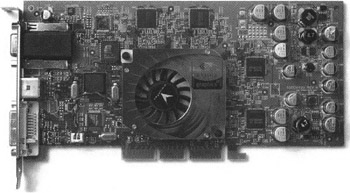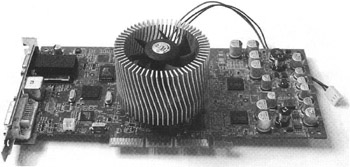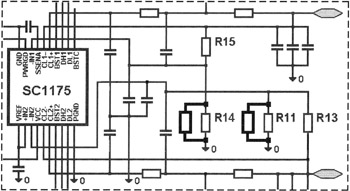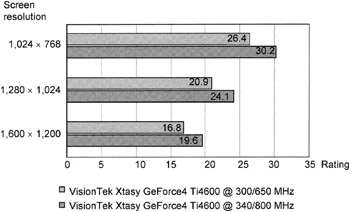Modifying and Overclocking GeForce4 Ti4600
|
| < Day Day Up > |
|
Nvidia GeForce4 Ti4600 is the most powerful member of the Ti4xxx chip family.
An example of the products based on this chip is the VisionTek Xtasy GeForce4 Ti4600 video adapter (Figs. 14.45 and 14.46).

Figure 14.45: VisionTek Xtasy GeForce4 Ti4600 adapter (front side)

Figure 14.46: VisionTek Xtasy GeForce4 Ti4600 adapter (underside)
The performance of this video adapter is relatively high. Nevertheless, even this high-performance product, like its predecessors, can be modified and overclocked. (Note that this might cause the adapter failure.)
Modifying the Adapter
Operations described for Xtasy GeForce4 Ti4400 were performed for this adapter.
First, the video chip surface was leveled and polished to make it flat. Then, the standard cooler was replaced with the more powerful one tested in the previous experiment.
After modification, the video adapter looked as shown in Fig. 14.47.

Figure 14.47: VisionTek Xtasy GeForce4 Ti4600 after modification
Maximum frequencies at which Xtasy GeForce4 Ti4600 operation was stable without increasing the voltage (i.e., in the moderate overclocking modes) was 315/750 MHz (375 MHz DDR).
Increasing the Voltage and Extreme Overclocking
On VisionTek Xtasy GeForce4 Ti4600, like all products based on Nvidia GeForce4 Ti4600 and manufactured according to the reference design, the supply of the graphical core is ensured using the SC1102CS stabilizer from Semtech. This chip is a controller for the pulse power-supply units and DC/DC converters. Output voltage of the stabilizer is specified by the R8:R7 resistor ratio (marked as in the typical connection design) and is calculated according to the following formula:
| (Formula 14.9) |
Here, Vref is the reference voltage; for SC1102CS, it is 1.265 V. The resistors in this formula are numbered according to the typical connection design shown in Fig. 14.35. A fragment of this method is in Fig. 14.48.

Figure 14.48: Fragment of the SC1102CS connection design
The simplest way to increase the supply voltage of the graphical core is to reduce the resistance R7 (in the typical connection design) by shunting it with an additional resistor, connected in parallel. This task was accomplished by soldering a 1-kilohm resistor to pins 11 and 14 of the SC1102CS chip (Fig. 14.49).

Figure 14.49: Voltage stabilizer for the SC1102CS chip
As a result, the R8:R7 ratio (according to the typical connection design) has changed, and output voltage of the stabilizer has been raised from 1.66 V to 1.81 V.
In the course of experiments, the supply voltage on the video chip was increased even higher — to 2.0 V. However, this didn't provide additional frequency growth during overclocking. The maximum frequency at which the graphical core was capable of operating under conditions of extreme overclocking was 340 MHz. The optimal frequency of the Nvidia GeForce4 Ti4400 chip under conditions of extreme overclocking proved to be the same. Presumably, 340 MHz to 350 MHz is the limit set by the internal architecture and manufacturing technology of Nvidia GeForce4 Ti4600/Ti4400.
Finally, a decision was made to stop raising the voltage after it has been increased only 9%. This was done because it is undesirable to expose the chip to the risk of being destroyed, especially after it was discovered that the frequency limit could be reached with a small voltage increase.
The power supply to memory chips is ensured by the stabilizer based on the SC1175CSW chip. This controller of the pulse stabilizer is similar to SC1102CS, but it has two independent channels. On adapters based on Nvidia GeForce4 Ti4600, one channel of this stabilizer ensures a power supply to internal circuitry and to the input/output buffers of the video memory chips (Vdd/Vddq). The other stabilizes the workload voltage (Vtt) for coordinating circuits by the impedance.
The supply voltages of the internal circuits and input/output buffers coincide for the chips used in Nvidia GeForce4 Ti4600; therefore, Vdd and Vddq are connected, and chips are supplied by one channel of the SC1175CSW stabilizer. The output voltage on the stabilizer is set by the resistance ratio, according to the following formulas:
| (Formula 14.10) |
| (Formula 14.11) |
Here, the Vref for SC1175CSW is 1.25 V, and the resistance numeration corresponds to the typical connection design (Fig. 14.50).

Figure 14.50: Fragment of the SC1175CSW connection design
The default supply voltage of the video memory chips was 2.83 V.
The Vout1 voltage was increased by shunting the R14 resistor with an additional 720-ohm resistor that was soldered to pins 18 and 20 of the controller chip (Fig. 14.51).

Figure 14.51: Voltage stabilizer of the video core
At the same time, the supply voltage of the video memory was increased to 3.09 V. With such a voltage supplied to video memory, the video adapter operation was unstable; ripples and list pixels appeared. These problems arose when the test computer was booted. Because of this, a decision was made to stop increasing the voltage at 3.09 V. As a result, the video-memory supply voltage was increased only 9.2%.
The maximum video-memory frequency at which VisionTek Xtasy GeForce4 Ti4600 operated reliably was 800 MHz (400 MHz DDR).
After modification, the maximum frequencies of the graphical core and video memory on VisionTek Xtasy GeForce4 Ti4600 were 340/800 MHz (400 MHz DDR). This is a good result, especially because the supply voltages of the graphical core and video memory were raised only 9%. The video core frequency was increased only 13.3%, and the video memory frequency was increased 23.1%.
Overclocking and Testing
The following hardware configuration was used to test the modified video adapters:
-
Processor — AMD Athlon XP 2000+
-
Motherboard — MSI K7T266 Pro2 v2.0 (VIA KT266A)
-
RAM — 2 × 256 MB, DDR SDRAM, PC 2700, Crucial CL2.5
-
Hard disk — Fujitsu MPF3153AH
The following software was used:
-
Driver — Nvidia Detonator v. 29.20 for Windows XP
-
Operating system — Windows XP
-
Tests — Codecult Codecreatures and 3DMark2001 SE
The default settings were used in the Codecult Codecreatures test.
The following parameters specified the operating modes in 3DMark2001: 32-bit frame buffer, 32-bit textures, 32(24)-bit Z-buffer, and D3D Pure Hardware T&L.
The performance growth under conditions of extreme overclocking was approximately 20% in the 3DMark2001 test (Fig. 14.52).

Figure 14.52: Test results obtained using 3DMark2001 (Nature)
With the Codecreatures test, the performance gain was smaller. This is not surprising because this test is more sensitive to the growth of the graphical core frequency than to video memory overclocking. Extreme overclocking increased the core frequency only 13.3% (Fig. 14.53).

Figure 14.53: Test results obtained using Codecult Codecreatures
Conclusion
The results of extreme overclocking of VisionTek Xtasy GeForce4 Ti4600 cannot be considered outstanding. The reason is that the nominal clock frequencies of the graphical core and video memory are close to the frequency limit set by the chip architecture and the manufacturing technology. In such a situation, it doesn't make sense to hope for good overclocking potential.
|
| < Day Day Up > |
|
EAN: 2147483647
Pages: 111
- Chapter III Two Models of Online Patronage: Why Do Consumers Shop on the Internet?
- Chapter IV How Consumers Think About Interactive Aspects of Web Advertising
- Chapter V Consumer Complaint Behavior in the Online Environment
- Chapter X Converting Browsers to Buyers: Key Considerations in Designing Business-to-Consumer Web Sites
- Chapter XVI Turning Web Surfers into Loyal Customers: Cognitive Lock-In Through Interface Design and Web Site Usability